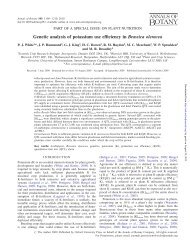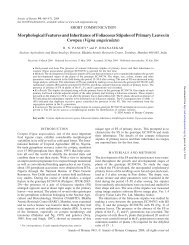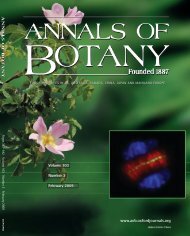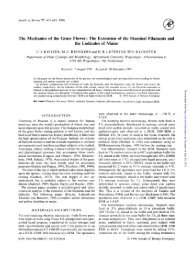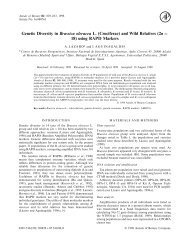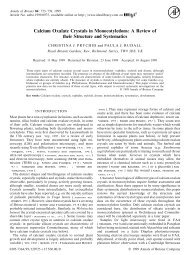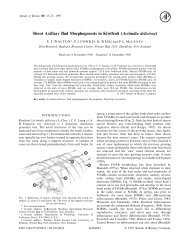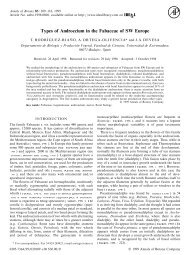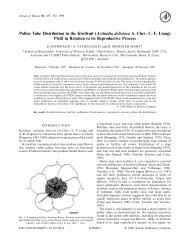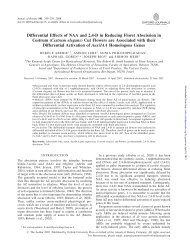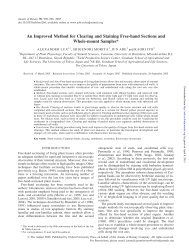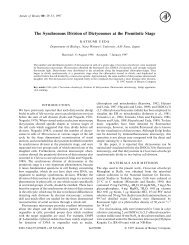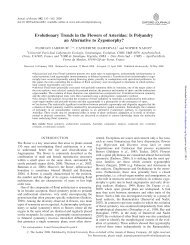Intraspecific Variation in Viola suavis in Europe ... - Annals of Botany
Intraspecific Variation in Viola suavis in Europe ... - Annals of Botany
Intraspecific Variation in Viola suavis in Europe ... - Annals of Botany
You also want an ePaper? Increase the reach of your titles
YUMPU automatically turns print PDFs into web optimized ePapers that Google loves.
TABLE 3. Analysis <strong>of</strong> molecular variance (AMOVA) <strong>of</strong> AFLP data performed with different group<strong>in</strong>gs with<strong>in</strong> <strong>Viola</strong> <strong>suavis</strong><br />
(exclud<strong>in</strong>g population no. 25 and 27; 128 <strong>in</strong>dividuals, 149 AFLP fragments)<br />
Group<strong>in</strong>g Source <strong>of</strong> variation d.f. Sum <strong>of</strong> squares Variance components % <strong>of</strong> total variance<br />
A. [Spa<strong>in</strong>],[C & SE Eu] Among groups 1 225.96 4.251 51.01 %***<br />
Among populations 26 448.66 3.702 44.42 %***<br />
With<strong>in</strong> populations 100 38.05 0.381 4.57 %***<br />
B. [blue-fl.],[white-fl.] Among groups 1 87.80 1.002 16.02 %***<br />
Among populations 26 586.83 4.871 77.89 %***<br />
C. [Spa<strong>in</strong>],[C & SE Eu,<br />
white-fl.],[C & SE Eu,<br />
blue-fl.]<br />
D. [Spa<strong>in</strong>, white-fl.],<br />
[Spa<strong>in</strong>, blue-fl.], [C & SE<br />
Eu, white-fl.], [C & SE<br />
Eu, blue-fl.]<br />
With<strong>in</strong> populations 100 38.05 0.381 6.08 %***<br />
Among groups 2 317.8 3.438 50.03 %***<br />
Among populations 25 356.82 3.054 44.44 %***<br />
With<strong>in</strong> populations 100 38.05 0.381 5.54 %***<br />
Among groups 3 387.62 4.006 57.79 %***<br />
Among populations 24 287 2.545 36.72 %***<br />
With<strong>in</strong> populations 100 38.05 0.381 5.49 %***<br />
blue-fl., blue-flowered populations; white-fl., white-flowered populations; C & SE Eu, central and south-eastern <strong>Europe</strong>; d.f., degrees <strong>of</strong> freedom;<br />
***, P , 0.001.<br />
Intrapopulational variation was generally low <strong>in</strong> V. <strong>suavis</strong>,<br />
as seen both <strong>in</strong> low with<strong>in</strong>-population component <strong>of</strong> total<br />
variance shown by AMOVA and <strong>in</strong> the neighbor-jo<strong>in</strong><strong>in</strong>g<br />
tree. Individuals from the same population mostly clustered<br />
together; only a few populations appeared somewhat heterogeneous<br />
(Fig. 3). With<strong>in</strong> population no. 25, sampled<br />
after flower<strong>in</strong>g, the AFLP data clearly confirmed the occurrence<br />
<strong>of</strong> both the white- and blue-flowered <strong>in</strong>dividuals.<br />
Interest<strong>in</strong>gly, much lower genetic variation was observed <strong>in</strong><br />
the white-flowered populations than <strong>in</strong> blue-flowered ones<br />
(see the number <strong>of</strong> AFLP phenotypes summarized <strong>in</strong><br />
Table 2). This pattern is supported also at the level <strong>of</strong> <strong>in</strong>dividual<br />
AFLP fragments. Private fragments were found <strong>in</strong> both<br />
blue-flowered morphotypes, but no such fragments were<br />
present <strong>in</strong> the Iberian white-flowered morphotype, and only<br />
a s<strong>in</strong>gle one was present <strong>in</strong> the C & SE <strong>Europe</strong>an whiteflowered<br />
populations (Table 2). In addition, there were<br />
altogether 13 fragments present <strong>in</strong> the C & SE <strong>Europe</strong>an blueflowered<br />
populations that were absent <strong>in</strong> the white-flowered<br />
ones, but only one fragment when count<strong>in</strong>g vice versa. The<br />
same number <strong>of</strong> AFLP fragments (13) was present <strong>in</strong> the<br />
Iberian blue-flowered populations but absent <strong>in</strong> the whiteflowered<br />
ones, but only two fragments vice versa.<br />
Morphometric analyses<br />
Spearman correlation coefficients did not reveal highly<br />
correlated pairs <strong>of</strong> characters that could distort further<br />
analyses. PCA computed on all <strong>in</strong>dividuals <strong>of</strong> V. <strong>suavis</strong><br />
(matrix A) and 20 characters showed three group<strong>in</strong>gs: (1)<br />
Iberian white-flowered populations; (2) C & SE <strong>Europe</strong>an<br />
white-flowered populations; and (3) blue-flowered populations<br />
from the whole area sampled (Fig. 5; only the<br />
two-dimensional graph is shown s<strong>in</strong>ce the third axis did<br />
not contribute to further differentiation). Eigenvectors<br />
express<strong>in</strong>g correlations <strong>of</strong> the characters with the axes<br />
were rather low, imply<strong>in</strong>g that numerous characters contributed<br />
almost equally to the components and that none <strong>of</strong><br />
them had a major impact (Table 1). In the PCA (matrix<br />
A) exclud<strong>in</strong>g the five characters express<strong>in</strong>g anthocyan<br />
Mered’a et al. — <strong>Intraspecific</strong> <strong>Variation</strong> <strong>in</strong> <strong>Viola</strong> <strong>suavis</strong> 453<br />
pigmentation (LP, PP, KP, CP and CPSP) apparently less<br />
structure was seen. Nevertheless, the white-flowered<br />
populations from C & SE <strong>Europe</strong> were clearly separated<br />
from those from Spa<strong>in</strong> (along axis 1), although they<br />
both overlapped with the blue-flowered samples [cf.<br />
Supplementary Information (2), available onl<strong>in</strong>e]. The<br />
characters with the highest eigenvector values for the first<br />
axis were the shape <strong>of</strong> lam<strong>in</strong>a base (LSA, –0.436; LSL,<br />
0.399), <strong>in</strong>sertion <strong>of</strong> bracteoles on peduncle (PL1/PL,<br />
0.339), and width <strong>of</strong> anterior sepals (KAW, 0.333).<br />
Two cluster analyses (matrix A, 20 characters) yielded<br />
results consistent with the PCA ord<strong>in</strong>ation (figures not<br />
shown). In the UPGMA dendrogram, the white-flowered<br />
populations formed two dist<strong>in</strong>ct clusters: samples from<br />
Spa<strong>in</strong> grouped <strong>in</strong> a cluster formed at a higher distance<br />
level, <strong>in</strong>dicat<strong>in</strong>g their morphological dist<strong>in</strong>ction, while<br />
those from C & SE <strong>Europe</strong> formed a cluster embedded <strong>in</strong><br />
the blue-flowered populations. No geographic structur<strong>in</strong>g<br />
among the blue-flowered populations was found; those<br />
from Spa<strong>in</strong> were <strong>in</strong>term<strong>in</strong>gled with the C & SE <strong>Europe</strong>an<br />
ones. Cluster<strong>in</strong>g with the MISSQ algorithm divided the<br />
samples <strong>in</strong>to two major groups: the blue-flowered populations<br />
and the white-flowered ones. With<strong>in</strong> the whiteflowered<br />
group, populations from C & SE <strong>Europe</strong> and<br />
Spa<strong>in</strong> constituted two separate clusters, but no geographic<br />
structur<strong>in</strong>g was found with<strong>in</strong> the blue-flowered group.<br />
To test for morphological dist<strong>in</strong>ction <strong>of</strong> the four groups<br />
resolved by AFLP data and to see differentiation at the<br />
level <strong>of</strong> <strong>in</strong>dividual plants (rather than population averages<br />
as above), a series <strong>of</strong> CDA based on matrix B (figures<br />
not shown) was performed. CDA was run for the pairs<br />
<strong>of</strong> groups, both with (19 characters exclud<strong>in</strong>g CP, which<br />
was <strong>in</strong>variable with<strong>in</strong> the groups) and without (14 characters)<br />
the pigmentation characters. The results were highly<br />
concordant with the PCA results. Clear dist<strong>in</strong>ction was<br />
achieved between the two white-flowered morphotypes<br />
(based on the characters PL1/PL, LSA, CPW, LSL and<br />
CPL), as well as between the two colour-morphotypes <strong>in</strong><br />
Spa<strong>in</strong> (characters CPL, CPW, CPSP, PP, KAW, LP and<br />
KAL). Some overlap, <strong>in</strong>dicat<strong>in</strong>g less differentiation, was<br />
Downloaded from<br />
http://aob.oxfordjournals.org/ by guest on March 20, 2013




